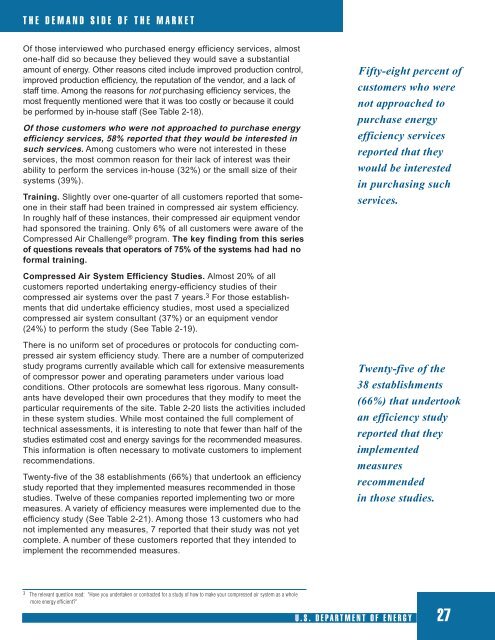Assessment of the Market for Compressed Air Efficiency Services
Assessment of the Market for Compressed Air Efficiency Services
Assessment of the Market for Compressed Air Efficiency Services
- No tags were found...
You also want an ePaper? Increase the reach of your titles
YUMPU automatically turns print PDFs into web optimized ePapers that Google loves.
THE DEMAND SIDE OF THE MARKETOf those interviewed who purchased energy efficiency services, almostone-half did so because <strong>the</strong>y believed <strong>the</strong>y would save a substantialamount <strong>of</strong> energy. O<strong>the</strong>r reasons cited include improved production control,improved production efficiency, <strong>the</strong> reputation <strong>of</strong> <strong>the</strong> vendor, and a lack <strong>of</strong>staff time. Among <strong>the</strong> reasons <strong>for</strong> not purchasing efficiency services, <strong>the</strong>most frequently mentioned were that it was too costly or because it couldbe per<strong>for</strong>med by in-house staff (See Table 2-18).Of those customers who were not approached to purchase energyefficiency services, 58% reported that <strong>the</strong>y would be interested insuch services. Among customers who were not interested in <strong>the</strong>seservices, <strong>the</strong> most common reason <strong>for</strong> <strong>the</strong>ir lack <strong>of</strong> interest was <strong>the</strong>irability to per<strong>for</strong>m <strong>the</strong> services in-house (32%) or <strong>the</strong> small size <strong>of</strong> <strong>the</strong>irsystems (39%).Training. Slightly over one-quarter <strong>of</strong> all customers reported that someonein <strong>the</strong>ir staff had been trained in compressed air system efficiency.In roughly half <strong>of</strong> <strong>the</strong>se instances, <strong>the</strong>ir compressed air equipment vendorhad sponsored <strong>the</strong> training. Only 6% <strong>of</strong> all customers were aware <strong>of</strong> <strong>the</strong><strong>Compressed</strong> <strong>Air</strong> Challenge ® program. The key finding from this series<strong>of</strong> questions reveals that operators <strong>of</strong> 75% <strong>of</strong> <strong>the</strong> systems had had n<strong>of</strong>ormal training.<strong>Compressed</strong> <strong>Air</strong> System <strong>Efficiency</strong> Studies. Almost 20% <strong>of</strong> allcustomers reported undertaking energy-efficiency studies <strong>of</strong> <strong>the</strong>ircompressed air systems over <strong>the</strong> past 7 years. 3 For those establishmentsthat did undertake efficiency studies, most used a specializedcompressed air system consultant (37%) or an equipment vendor(24%) to per<strong>for</strong>m <strong>the</strong> study (See Table 2-19).There is no uni<strong>for</strong>m set <strong>of</strong> procedures or protocols <strong>for</strong> conducting compressedair system efficiency study. There are a number <strong>of</strong> computerizedstudy programs currently available which call <strong>for</strong> extensive measurements<strong>of</strong> compressor power and operating parameters under various loadconditions. O<strong>the</strong>r protocols are somewhat less rigorous. Many consultantshave developed <strong>the</strong>ir own procedures that <strong>the</strong>y modify to meet <strong>the</strong>particular requirements <strong>of</strong> <strong>the</strong> site. Table 2-20 lists <strong>the</strong> activities includedin <strong>the</strong>se system studies. While most contained <strong>the</strong> full complement <strong>of</strong>technical assessments, it is interesting to note that fewer than half <strong>of</strong> <strong>the</strong>studies estimated cost and energy savings <strong>for</strong> <strong>the</strong> recommended measures.This in<strong>for</strong>mation is <strong>of</strong>ten necessary to motivate customers to implementrecommendations.Twenty-five <strong>of</strong> <strong>the</strong> 38 establishments (66%) that undertook an efficiencystudy reported that <strong>the</strong>y implemented measures recommended in thosestudies. Twelve <strong>of</strong> <strong>the</strong>se companies reported implementing two or moremeasures. A variety <strong>of</strong> efficiency measures were implemented due to <strong>the</strong>efficiency study (See Table 2-21). Among those 13 customers who hadnot implemented any measures, 7 reported that <strong>the</strong>ir study was not yetcomplete. A number <strong>of</strong> <strong>the</strong>se customers reported that <strong>the</strong>y intended toimplement <strong>the</strong> recommended measures.Fifty-eight percent <strong>of</strong>customers who werenot approached topurchase energyefficiency servicesreported that <strong>the</strong>ywould be interestedin purchasing suchservices.Twenty-five <strong>of</strong> <strong>the</strong>38 establishments(66%) that undertookan efficiency studyreported that <strong>the</strong>yimplementedmeasuresrecommendedin those studies.3 The relevant question read: “Have you undertaken or contracted <strong>for</strong> a study <strong>of</strong> how to make your compressed air system as a wholemore energy efficient?”U.S. DEPARTMENT OF ENERGY27
















